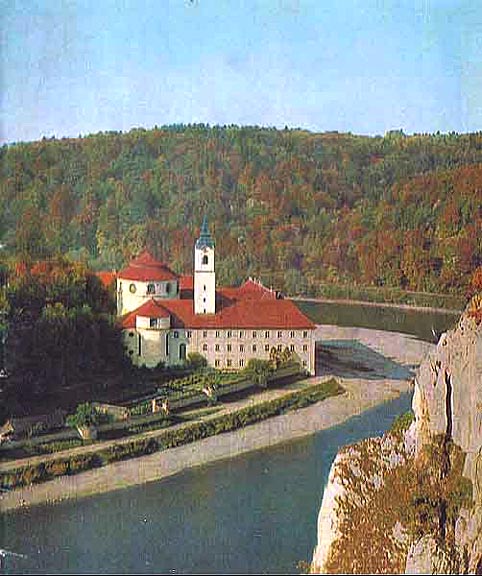
The Benedictine Abbey Weltenburg lies in a lovely bend of the Danube Gorge west of Kehlheim
Ballrooms
for Angels
Southern
German Baroque Churches
Lower Bavaria, the Upper
Palatinate, and Frankonia
Google-Map
Lower Bavaria and the Upper Palatinate
Few visitors venture north of Freising and München into Lower Bavaria and the Upper Palatinate, where they would find two of the most exalted Baroque churches in Bavaria: Weltenburg and Rohr by the Brothers Asam and the architectural beginnings of Johann Michael Fischer, who was born in the Palatinate. These places are off the “Romantic Tourist Route” from Rothenburg to München.
Kloster Weltenburg 1716-29

The
Benedictine Abbey Weltenburg lies in a lovely bend of the Danube
Gorge west of Kehlheim
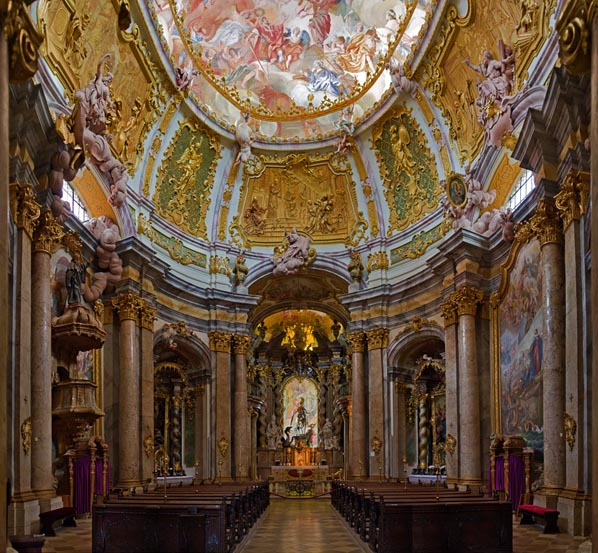
The
oval interior
The interior is by far the most riotious Baroque church anywhere. Built by Cosmas Damian (architect) and Egid Quirin Asam (stuccateur and painter), the interior is a dark gilded oval cage. It is much daker than the photograph – lightened to show the details – suggests. The only light comes from a large opening in the ceiling and from a mysterious window in the apse behind the high altar.
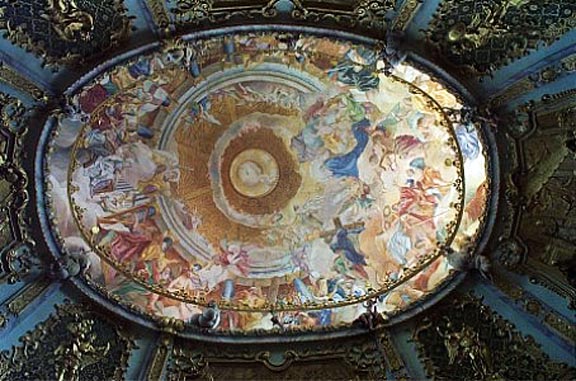
The
ceiling opening

The non-plus-ultra is St. George in gilded armor riding onto
the high altar. He is nonchalantly threatening a fire-spewing dragon
which is held by the Lydian princess on an invisible woolen
thread....
This altar beats any of Bernini's creations in Rome to
which the Asams are obviously indebted.
Klosterkirche Rohr 1717-22

The
monastery, dedicated to the Assumption of the Blessed Virgin Mary,
was founded in 1133.
The church was rebuilt by the Asam Brothers
in 1717-22)
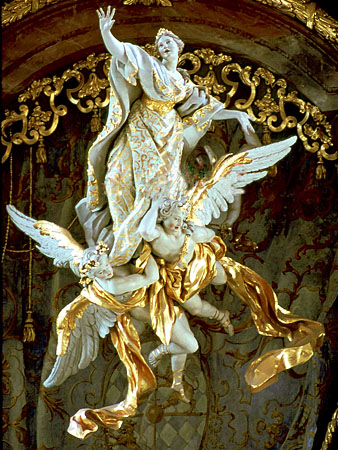
Mary's
ascension
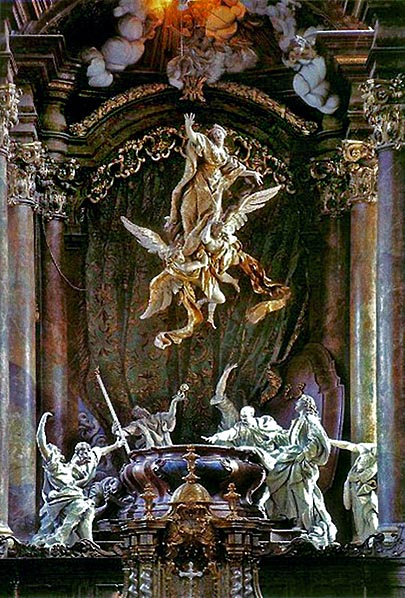
On the high altar Mary rises from her tomb. The Apostles gesticulate at the empty sarcophagus, while fantastically illuminated from the back the Son of God receives her in heaven. Other Asam altars are more mystical, this is their most theatrical stage setting
Johann Michael Fischer's Earliest Buildings
Niederaltaich St. Mauritius and St Nicholas1724–1726
Niederalteich is unique for rual Bavaria, its services are today held
alternatingly in the Roman Catholic and the Byzantine Orthodox rites.
Basilica
Niederaltaich

The
mighty Gothic church.
The Baroque upper extension of the towers
is by Johann Michael Fischer
The earliest surviving commission of Johann Michael Fischer confronted him with an imposing 3-nave Gothic church, which he was expected to convert to the latest Baroque taste of the Counter Reformation

He enlarged the windows, moved the side altars aside, applied stucco
sparingly, and flooded the space with light,
succeeding in
converting the mystical Gothic nave into an open, jubilantly swinging
sequence of Baroque spaces.
Osterhofen-Altenmarkt 1727–1740
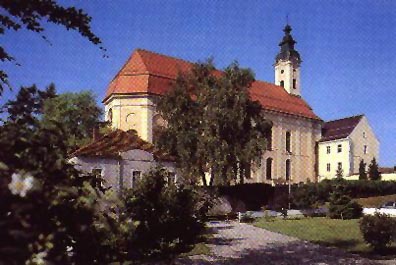
The unpretentious exterior of the church
The Abbey was originally (1004-1138) a collegiate, which in 1138 became a Premonstratensian monastery. In 1727 Premonstratensians commissioned Johann Michael Fischer to build a new Church of St. Margareta, and called on the Brothers Cosmas Damian und Egid Quirin Asam to decorate the interior, stucco, frescoes, and the high altar.
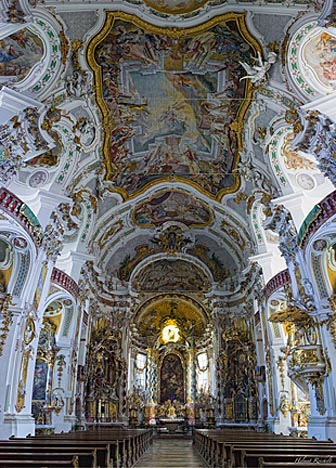
Interior Nave
The Asams were already famous in Lower Bavaria for their churches at Rohr and Weltenburg, and in fact St. Margareta is popularly known as “Asam Basilica”. However for the 34-year old Fischer it was only his second major commission. The colaboration proved most felicitous.
Fischer for the first time resolved the challenge of the
inherited Voralberger wall-pilaster scheme by inserting rounded
second story oratory balconies between the pilasters. He divided the
nave into three spaces with a coupola over the, only indicated
quadrature. He would employ this schema again in Zwiefalten, though
he only found in Ottobeuren and in Rott am Inn a more pleasing
spatial solution.
Fischer's architecture is, despite the grand
decorarions of the Asams, what makes this building important. - It is
very difficult to find good photographs of this church in the
internet, and I ask all readers to send me better ones.
Aufhausen
1736–1751
Pigrimage Church Maria Schnee

Aufhausen is the only work of Fischer in his Upper Palatinate home. Built 9 years after Osterhofen Fischer tries a variation on the floor plan of his St. Anna im Lehel (1727). The exterior is, apart from the curving southern facade, very simply. The onion-shaped tower was only added in 1761
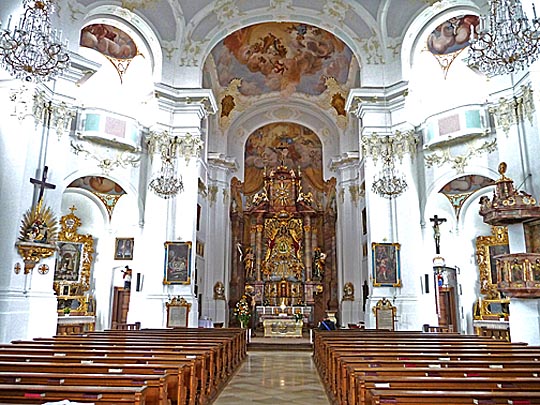
The rectangular outside does not reveal an octagonal nave.
At
the ends of the four diagonal axes oratories upstairs are echos of
Osterhofen
Frankonia
Balthasar Neumann 1687-1753
Johann Balthasar Neumann was born
in Eger, Bohemia (today Cheb/Czech Rep.) He was the only professional
architect in the modern sense among the master builders of the
Bavarian Baroque. He worked in Frankonia, in the Main Valley in the
employ of Joh. Philip Franz von Schönborn, Fürstbischof (Princely
Bishop) of Würzburg .
His most ambitious building
project is the "Residenz" in Würzburg, the Palais of the
Fürstbischof, which I'll describe elsewhere.
Hofkirche of the Residenz in Würzburg 1720-44
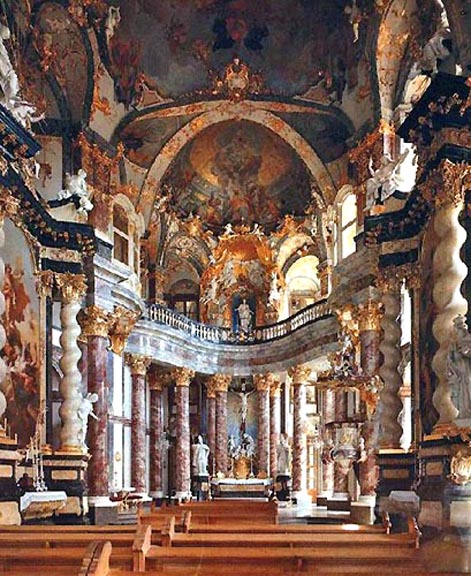
The
Hofkirche of the Fürstbischöfliche Residenz in Würzburg
The church of the Fürstbischöfliche Residenz in Würzburg is a tour de force of the late Baroque influenced by Bohemian, Austrian, and in the end Bernini's examples - like the spiral columns from St. Peter in Rome
Monastery and Church Vierzehnheiligen 1743–1772

The
pilgrimage Church of Vierzehnheiligen,"Fourteen Saints",
occupies a spectacular location high above the Main Valley.
Some of the larger Bavarian Baroque churches share a difficult design history. The simple master builders (masons) were often not able to to solve the spatial and architectural demands made by large buildings. Such was the well-documented case of Ottobeuren. In Vierzehnheiligen the issue was complicated by the fixed location of the miraculous altar. When Neumann was called upon to finish the building Gottfried Heinrich Krohne had begun, and Neumann was faced with already one-story-high foundations.
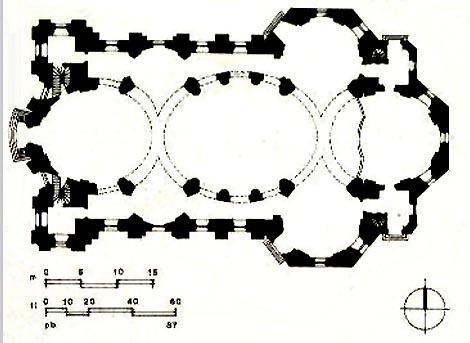
In one of his most daring floor plans Neuman inserted his design into
the the existing, rectangualr structure:
three interlacing
ellipses flooded by light.

The miraculous altar, originally under Krohne's quadrature, stands now at the center of the largest ellipse, giving the ilusion that it is at the center of the church. The result is a swinging curved space with no antecedents or followers in Germany. - Not a perfect photograph, the colors are distorted, but the only one from the height of the organ prospect showing the spatial effect.
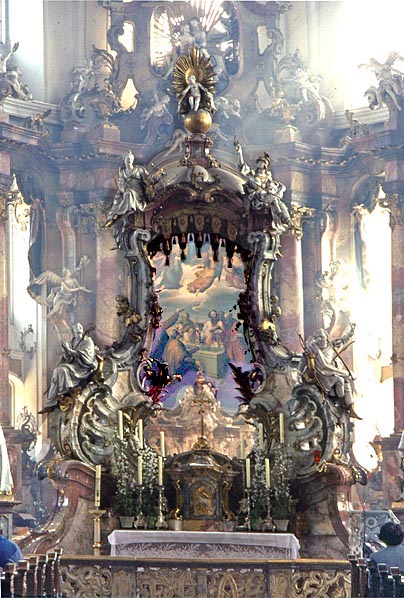
The
miracular altar in the incense clouds of Mary's Ascention Day
Würzburg, Käppele 1748-1752, 1787
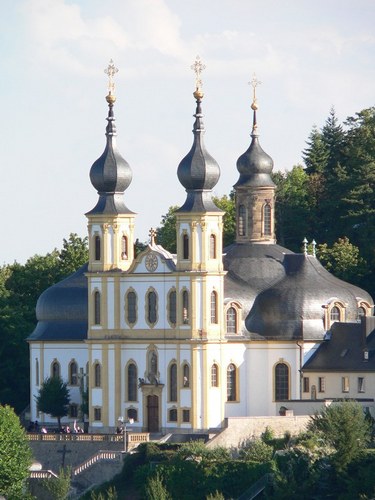
Locally known as “Das Käppele”, the pilgrimage church of the Capucine monastery on Nicholasberg next to the Marienburg overlooking the Main river was build by Balthasar Neumann (1740-1752). The stucco is by Johann Michael Feichtmayer, the frescoes by Matthäus Günther. A pilgrimage chapel, attached to the east of the church was left unchanged, until 30 years later (after Neumann's death) it was also redecorated by Matthäus Günther in 1787. - The interior and the fresoes are unfortunately rather dark (1994) - the organ is magnificent.
|
|
|
Kloster Neresheim 1747-1792
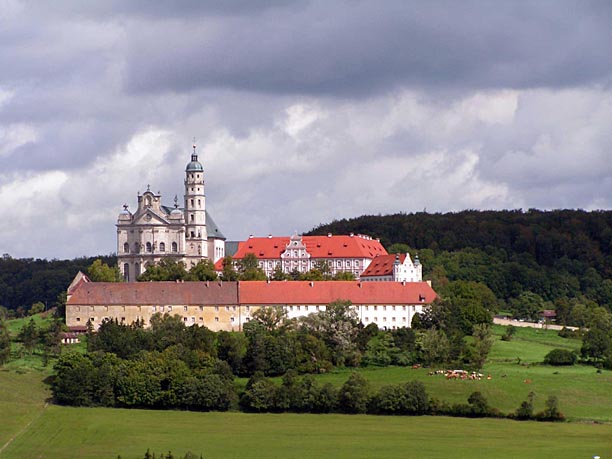
Kloster
Neresheim 1747-1792
Benedictine Monastery Church of the
Holy-Cross
Balthasar Neumann's last work.

Possibly
the grandest architectural creation of the Bavarian Baroque.
The first precursers of Classicism were in the air when Neumann designed this building. The interior is dominated by the dynamics of its fully exposed structural elements. We suddenly become aware that the elaborate stucco and the illusionary frescoes in Bavaria actually hide uninventive architectural forms. Here, where the stucco has remained minimal, the stresses and tensions of the architucture are fully sufficient to hold our attention.
|
|
|
|
Neumann died 1753 before the ceiling was finished. The local master builders decided to abandone Neumann's four semispherical copulas, flatten the ceiling, and hold it by wood trusses hidden in the high Gothic roof. The irony is that the dynamic stress supports Neumann had designed for the building are actualy no longer load-bearing. All photos by RWFG.
|
|
|
Nevertheless Martin Knoller's and Joseph Schoepf's (1775) frescoes are superb – and hide the nonspherical domes! Photos of frescoes by Juergen Kuehn
During the 1960 sonic booms from overflying American jet-fighters damaged the ceiling structure so badly that the church had to be closed. Twenty years of extensive repair stabilized the building.